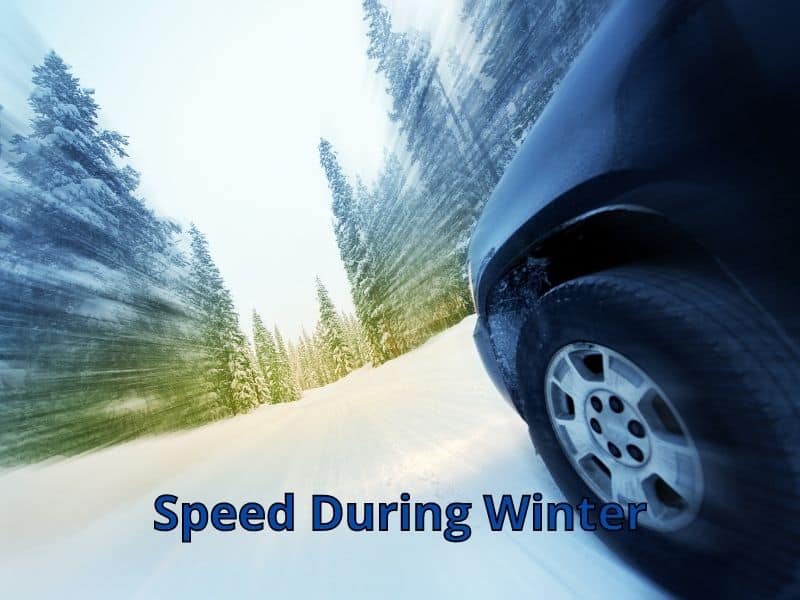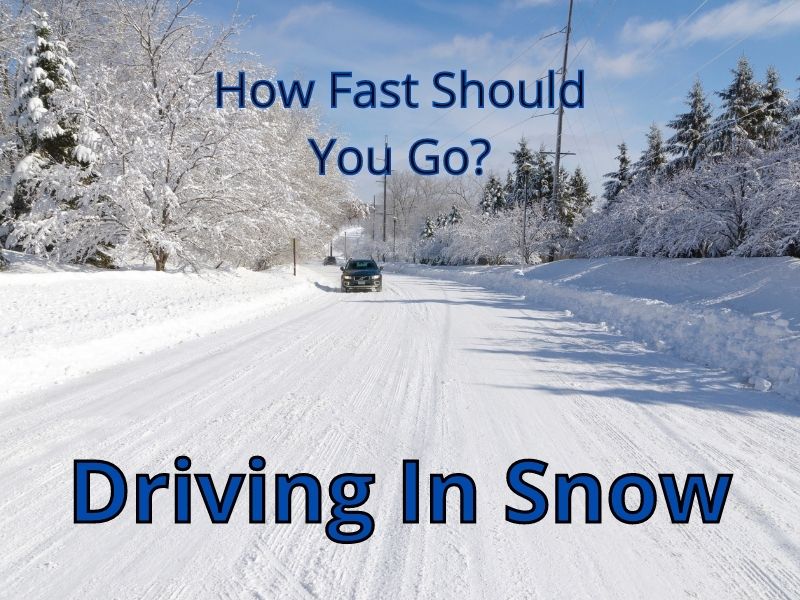Driving through streets that are loaded with snow during the winter season can be extremely risky. There is always a need to be extra cautious when driving your car through these roads. You may have heard that a sizeable number of accidents take place as a result of such conditions.
Drive up to 30 mph on freeways if snow has completely covered the ground and up to 20 mph along city streets. This all depends on the amount of snow, the type of snow, if you have chains, what type of tires you have. A general rule is: never drive faster than you feel confident driving and know your vehicle.
Below we will talk about how important it is to follow this strict rule of vehicle speed in snowy conditions to ensure your and your family’s safety as you drive this winter.
How Important Car Speed During Winter

As a rule of thumb, you will need to maintain a speed of 30 mph when you drive on a road full of snow. It is because the visibility on the streets is minimized, and it is more difficult to stop the vehicle.
Sometimes, you cannot avoid going out to run some errands even though it is snowing. Several families plan road trips to unfamiliar places during the winter months. These road trips will require them to stay on the road for a more extended period.
In such circumstances, the possibility of the vehicle getting stuck in the snow cannot be ruled out. As part of the safety measures, you may find the following driving tips for winter useful. Here are a few precautionary steps you can follow to ensure you will reach your destination safely.
10 Tips For A Safe Driving In Winter
Below are the ten tips for driving your car through a snowy road during winter. Remember to keep these tips in mind to ensure your safety and reach your destination without any problems.
1. Preparing Your Car
At the preparation stage, you must ensure that there is enough gas in your car. You surely do not want to be running out of gas when out in the cold. Additionally, if your vehicle has sufficient gasoline, you can leave it running to keep the car warm- in case you get stuck somewhere.
Checking the washer fluid of your car is also essential. It can help clear the snow, frost, or ice off your windshield. You must make sure that there is sufficient fluid for your wiper to function correctly.
Additionally, make sure that the solution added to the wiper fluid is suited for low temperatures. Some varieties tend to freeze. So, be careful if you do not use suitable fluid for the cold season.

It may also be helpful if you consider hiring a qualified car mechanic to inspect the functionality of the brake lights, fluids, threads, inflation of tires, and bulbs.
Keeping extra pairs of warm clothing, packaged drinking water, emergency toolkit, and snacks in the vehicle must also not be forgotten.
As a rule, do not place gadgets in the front seat as they can be distracting. Keep them in the backseat or the trunk. If possible, everybody who is traveling with you in the car should put away their gadgets.
2. Equipment Requisites
Some essential automotive tools that you may need for preparation before driving towards your destination include a kitty litter or a sack of sand and a shovel – these are useful in the event of a breakdown during snowy conditions.
Moreover, make sure to keep an ice scraper in the automobile. Use it for clearing snow from the windows, brake lights, headlights, mirrors, and the windshield.
Investing in premium-quality snow tires is also recommended. These provide the traction needed for preventing the car from getting out of control. For gaining maximum traction when cruising through snow-filled and ice-packed roads, you must consider only the best tire chains for the car. These devices are installed on the tires of automobiles.
3. Weather Update
You are also advised to keep yourself updated about the state of the weather to know what to expect and be better prepared. A wide variety of online resources are accessible that give the latest updates.
You may also avail of weather alerts during rough conditions. It is where you will get notifications regularly. However, be sure that you park your vehicle before reading the messages.
4. Safe Driving

It would be best if you took precautions to remain safe while driving through the snow-packed roads. Here, you must remove the snow that has collected on the vehicle for greater visibility.
Furthermore, light up the headlights for the entire duration that you are driving. You must also be aware of the probability of reduced visibility in sectors where big-sized piles of snow are lining the road.
It would be best if you also decreased the speed of your vehicle during wintertime, as per the conditions of the roads. Remember to maintain a speed of 30 mph for roads that are highly covered with snow. You can also opt to lower your speed more if needed.
Maintaining distance between cars ahead of your vehicle is also a safety measure that should be practiced when passing by ice-packed streets.
During harsh weather, it is advisable not to rely on your car’s auto cruise mechanism.
If more than one person holds a valid driving license, the drivers should take turns every few hours. If you are the sole driver, make a stopover every 90 minutes or so for taking a break and refreshments.
The wipers should be inspected and kept working to facilitate the removal of snow from the windshield. Try and be patient, do not panic, and never attempt to rush. It is crucial to think clearly.
5. Driving In Lanes
On multi-lane roads, stick to the lanes that are farthest from the curb. Keep your car in the center of the road on other routes, as snow tends to drift and collect on the sides. Driving your vehicle through present wheel markings can also help.
It would be best if you never attempt to shift lanes. The wheel could become stuck in ice, and you could lose control of the vehicle.
6. Avoid Overtaking

As much as possible, avoid overtaking other vehicles on the road. Never try to surpass brine or snowplow vehicles, as the road conditions could be far worse ahead. Also, overtaking on an icy highway can cause accidents.
7. Be Careful Of Black Ice
You must also be vigilant when passing through bridges during snowy weather. It is because the ice will likely build up over the surface of the road. Moreover, they could be covered with black ice, which is dark and difficult to see.
8. Managing When Stuck
Sadly, there are times that you may get stuck even after exercising the necessary precautions. In such cases, it is recommended to keep a clear mind and make efforts to get your vehicle off the road securely. Use blankets and warm clothes for comfort; always keep additional resources in your vehicle in case of an emergency.
- You may also consider keeping your car running for short durations at intervals for generating heat.
- Knowing the dangers of carbon monoxide toxicity is also important. So, you must ensure that the tailpipe is not being blocked with snow.
- It is also advised to use a shovel for removing the snow from beneath the automobile, around the wheels, and next to the exhaust.
- Moreover, keep the windows slightly open for breathing fresh air.
- If you have sand in your vehicle, then spread it near the front or rear tires depending on whether your car is a front-wheel or rear-wheel drive.
- Drive slowly while keeping the vehicle in low gear; also, do not attempt to spin the tires because it may result in damaging the transmitter or clutch and cause the snow to pile up underneath the tires.
- If possible, you should also try and move the car backwards and forwards for the car to gain momentum.
9. Precautions With Anti-Lock Brake System (ABS)

You must not pump the brakes during an emergency stopover if your car is mounted with an ABS. Upon releasing the brake, the braking system could go out of control. Instead, maintain constant pressure on the brake to keep the system functional.
10. Calling For Assistance
As a last resort, if you cannot remove your car from a snowbank, do not hesitate to call for help.
It is essential to remember that your expertise behind the wheel does not matter when driving down snowy-filled lanes through winter. It is important to be precautious, be aware of your surroundings, and prepare yourself to tackle any unwarranted situations.
Conclusion
In this context, driving slowly and staying alert is essential. Keeping yourself updated about the weather conditions is an integral part of the preparation phase and should not be missed.
Additionally, be sure that somebody knows your whereabouts, especially if you are traveling to a place where mobile phones do not operate. By doing so, it will be easy for the assistance authorities to locate you.
Thank you for visiting Drivinglife.net
References:

